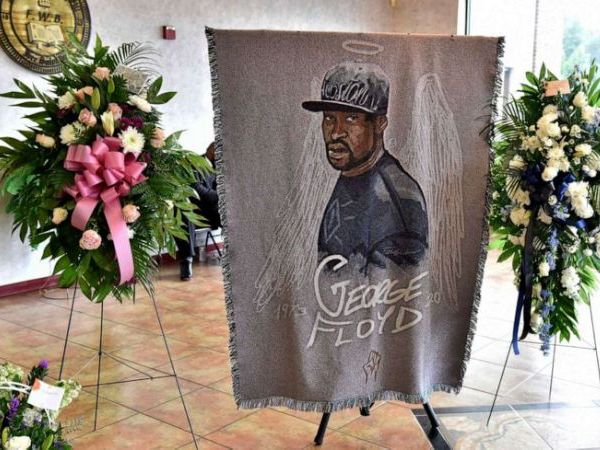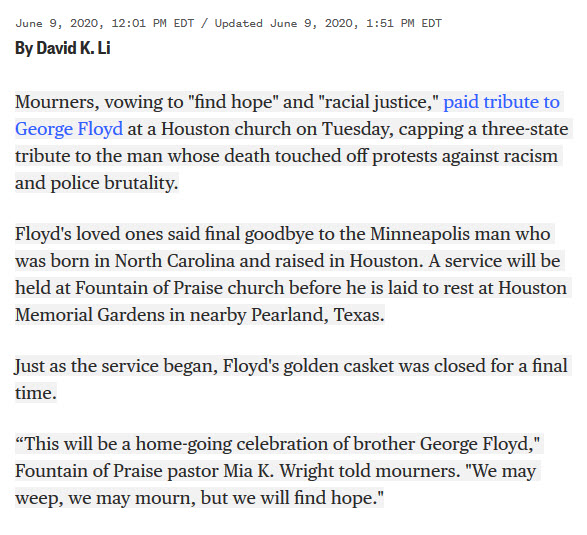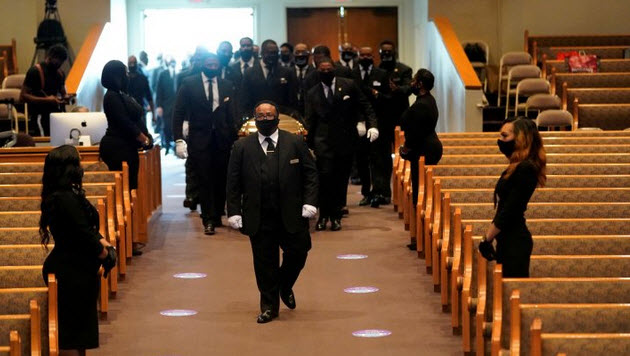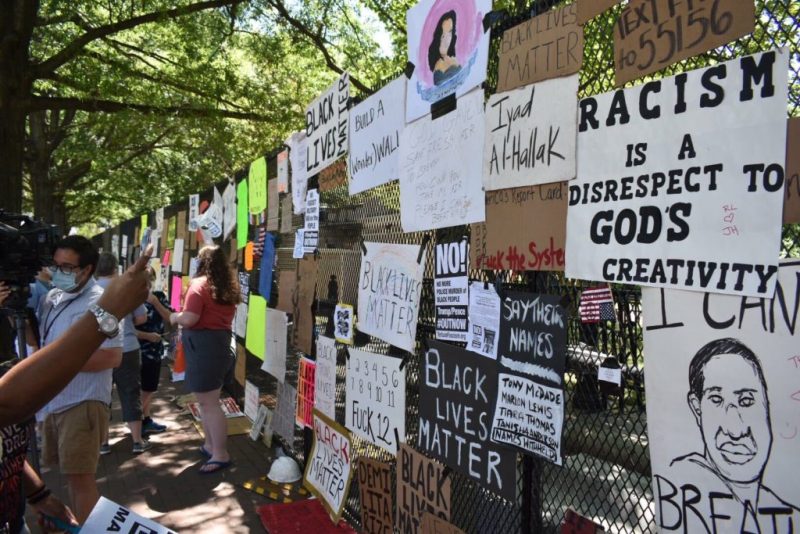File:George Floyd In-Memory.jpg
George_Floyd_In-Memory.jpg (600 × 450 pixels, file size: 68 KB, MIME type: image/jpeg)
Celebration of the life of George Floyd
Fountain of Praise Pastor Mia K. Wright said the funeral service for George Floyd would be a celebration of his life, and a moment of connectivity.
“In the tradition of the African American church, this will be a home-going celebration".
~
After the Memorial Service of George Floyd
There's a street in Savannah called River Street. The street is paved and bumpy with paver stones laid there alongside the
Savannah River. Few know these days that River Street is slave ship ballast, rocks that slave ships carried in their hold with the slaves. Over the yrs thousands of ships carried European-enslaved Africans, and African rocks -- chert, basalt -- quartz to the Southern city of Savannah, purposefully built on a native American graveyard site by an Englishman named General Oglethorpe.
The Africans had made a stop at Tybee Island, along Lazzaretto Creek, a lazzaretto its called, a quarantine stop. The chained people in the hold were counted, their saleable qualities written in detail on bills of lading and offer, preparing them for sale on River Street.
After they were unloaded, the African men then unloaded the rocks. This gave the slave traders an idea of how they would work in the fields. Then the slaves were chained to metal hooks in stonework along the river. The hooks are still there, tho few know what those rusty hooks in walls alongside River Street in Savannah were for. What people do know is that Savannah is known for being a haunted city. Not just because of all the literature, 'the book' and the movie that came from it, Midnight in the Garden of Good and Evil, and all the hanging moss, the deep humid smells, the whispers in the trees, the talk of spirits roaming still.
My first trip to Savannah told me this was a place where I should be very aware when I walked the streets at night. There are souls wandering still in Savannah. Savannah has lessons to tell us and if we stop and listen, we can hear them.
Stop and Listen
An old friend who used to edit at Roll Call and E&E Environment & Energy sent this to me. A June 9th editorial from his new venture, Maryland Matters.
Maryland does matter, as does its history, up the coast a bit from Georgia and split by pre Civil War Mason-Dixon line. The Province of Maryland saw the slavery line became a reality in 1767. Stones were placed every mile to mark the line between free and slave. Many of these original stones, rocks in the ground where on one side one could be free, in a manner of speaking, and on the other side, one could be owned and enslaved.
Let's look closer at the 'free' side in Maryland. Josh Kurtz and Maryland Matter lays it out for us. It's in the law, law and order of that time with the echoes still with us.
Read it slow, stop and listen to the voices:
Tucked between an early wrongful death statute titled “Negligence” and an article governing “Notaries Public,” sits Article 66 of the Maryland Code of 1860. Titled “Negroes,” Article 66 lays out the laws governing black life in the state of Maryland on the eve of the American Civil War across approximately 20 pages.
It is an example of one American state’s most fully formed corpus of law on the Black body. It is also an example of the American legal tradition of sanctioning and incentivizing the killing of black men by white citizens and law enforcement, a legacy reverberating in the recent murders of Ahmaud Arbery and George Floyd.
At the core of Article 66 is the impossibility of Black personhood, and this impossibility is achieved, in large part, by establishing a system of White control over the Black body. The article begins with the pronouncement that “Negroes have been held in slavery” in Maryland from its earliest settlement, and that “every owner of such negro is entitled to his service and labor for the life of such negro.” (Article 66, sec. 1).
This makes clear that there is no distinction between slave and Black person (“negro”), and that the power of Whites over Black bodies is perpetual. Later in the document (sec. 42), Article 66 prohibits the freeing of slaves by deed or last will and testament, meaning slaves could not be freed upon the death of their owner. This helped preserve the legal identity of the slave as property rather than person.
It is clear from Article 66 that this legal identity imposed on the Black body was enforced by conscripting White citizens into its enforcement. For example, section 47 required “All sheriffs and constables,” who then would have been White, to arrest any free Black person in the State from outside of Maryland, who were not allowed to enter the state (sec. 44).
But Article 66 also extended that same power to “all other [White] persons” who were also “authorized to arrest any such free negro” (sec. 47). White persons were not only authorized to arrest any free Black person from outside the state, they were entitled to half the $500 fine (in 1860) in the instance they arrested a free Black person for illegally entering Maryland a second time (sec. 44).
Thus, White persons were not only endowed with absolute authority over the bodies of “free” Black persons from outside Maryland, they were economically incentivized to exercise that authority and make White power over the Black body real. This economic incentivizing of the exercise of White power over the Black body is found throughout Article 66. (E.g., sec. 9, 46, 67-68, 70, 73).
Article 66 also encouraged White violence (read: use of force) against Black persons. For example, sec. 72 of Article 66 prohibited free Blacks from owning dogs without a permit, and the permit had to be renewed annually. The same section also authorizes “any person [to] kill any dog kept contrary to this section.”
In other words, any White person, upon the expiration of a Black person’s dog permit, had the legal right to kill that dog solely on that account. This is nothing other than the codification of an act of wanton cruelty against Black persons and families.
The greatest incitement to violence, however, rests in sections 3-11. Section 3 states that, “Any person may arrest any runaway negro, and carry him before a judge or justice.” Further, anyone attempting to do so was granted immunity for any use of force employed in the attempt:
“If any runaway slave shall resist the person who attempts to arrest him, and such slave happens to be slain for refusing to surrender himself, such killing shall be deemed justifiable; and any slave so killed shall be paid for by the State.” (sec. 11).
No other provision of Article 66 better contextualizes the rage currently being felt over the deaths of Black men at the hands of the State and their agents, many often White. How often has “resisting arrest” been used as a justification to murder a Black person? Here is its provenance in American law.
How often have we heard that the killing of a human being was justifiable because she resisted arrest? Here is its provenance in American law.
The Statues 'Honoring the Confederacy'
The memories from the past flow past us, a river of time in the South, the land of the 'Confederacy', the war to keep slavery a fact.
Here in Florida, where your writer resides, the ghosts of the past live in the present. Today, Confederate flags can be seen daily. Driving down the roads are Dixie flags in truck beds and rear windows, often displayed, if the words are said out in the open, by folks who believe still in 'the cause', the Southern cause in the Civil War.
Here in Florida, next to Georgia, not far from Savannah, the memories of slavery remain embedded in the land. Stone monuments to rebel troops, leaders and battlegrounds with places of 'honor' in our cities. Slavery's vestiges are still venerated, displayed and given salutes by some. But this is changing. The flow of time is bringing change, a new era even as those who honor the old ways call for another hurrah, another rebel yell.
But yesterday, June 9th, 2020, the tallest, historic Confederate monument was removed in the dark of night in Florida's largest city -- Jacksonville.
It happened in Hemming Plaza in the center of Jacksonville, the city named after the slayer of Indians, the seventh president of the United States known for slaughtering and removing the Native American tribes remaining in the South and marching them to reservations beyond the Mississippi River.
Andrew Jackson was celebrated for opening up 25 million acres of native peoples land to white settlement, in violation of treaties but there is was -- a slaughter in the name of 'civilization'. Their skin was dark, they had to go. They were 'savages'. They were hated. The Indian wars and white man plagues wiped out millions of the original people. Andrew Jackson led the troops against the Creek tribe. "We shot them like dogs," Davy Crockett is reported as saying in the news reports.
Three tribes had 21 million acres taken by Jackson who proclaimed to the US Congress, “They have neither the intelligence, the industry, the moral habits, nor the desire of improvement which are essential to any favorable change in their condition. Established in the midst of another and a superior race…they must necessarily yield to the force of circumstances and ere [before] long disappear.”
The U.S. Army removed 60,000 Indians. The removal and forced march was known as the “Trail of Tears.”
Today, in Andrew Jackson's city, Jacksonville, questions are being asked about how far the mayor who ordered the removal of the towering Hemming granite stone monument to the war for slavery.
What about the other Confederate monuments? Will they be removed too from their places 'of honor' in parks and be removed to museums and places where they will be regarded as historical artifacts with lessons to be learned about American past.
Or will the Jacksonville mayor go another way?
Today it was announced that Jacksonville looks to be the chosen site of the 2020 Republican convention. The US president decided, it's now being reported, that Florida is in, North Carolina is out. The long-planned convention in the Carolinas is being pulled as the North Carolina Governor was unwilling to give the president a demanded full-audience, no restrictions event in contravention to public health care experts warning against the spread of the Coronavirus, Covid-19.
And so it goes.
It used to be said that the powerful, the victors in war, write the history. To an extent, this has been shown to be true over the decades and centuries past.
Yet, there is another river of time, a River Street on which we are all traveling. It flows with its own force, it is a powerful force, moving, rippling, creating waves, eddies, currents.
The dynamic is happening here, today, with George Floyd, with the people rising up and saying 'let us breathe'. These are new times on River Street. We remember the old times. And we're learning.
~
GreenPolicy360
June 10, 2020
~
File history
Click on a date/time to view the file as it appeared at that time.
| Date/Time | Thumbnail | Dimensions | User | Comment | |
|---|---|---|---|---|---|
| current | 17:58, 9 June 2020 |  | 600 × 450 (68 KB) | Siterunner (talk | contribs) |
You cannot overwrite this file.
File usage
The following 2 pages use this file:



